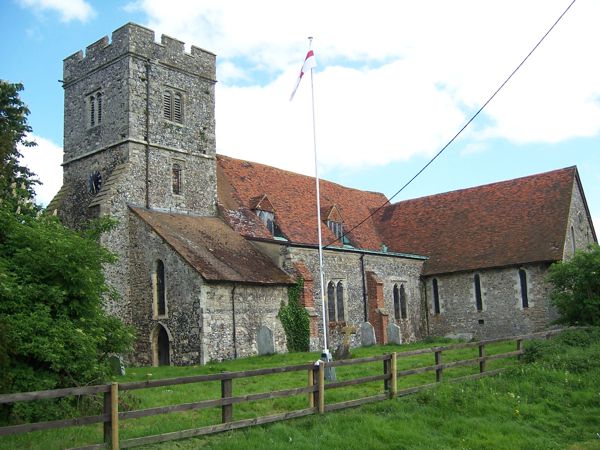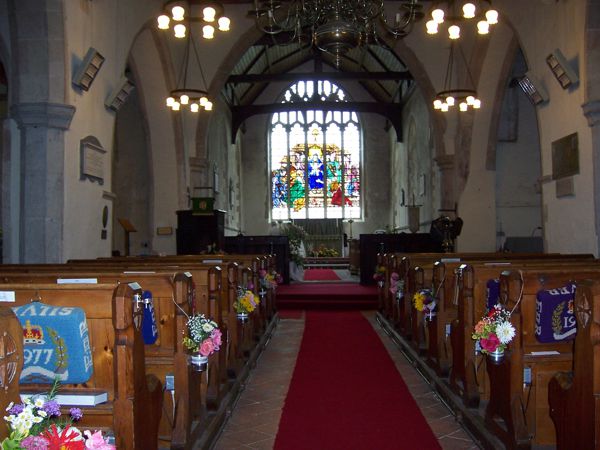The Parish Church of St. Mary, Teynham
Historically, Teynham is very ancient. A flint axe, found near the Station and now in the British Museum, testifies to the area being populated in Neolithic times; also, Roman remains and coins have been discovered in the district.
It is mentioned that Archbishops resided here in early times. Kenulf, King of Mercia, who reigned between the years 794 and 819, gave the place to Christchurch Canterbury, and afterwards a palace was built in close proximity to the Church. Archbishops Baldwin (1184-91), Hubert Walter, who died here (1193-1207), Langton (1207-29) and Raynold (1313-281 in turn lived here. The fact that Archbishop Kilwardby received his pallium from the Pope at Teynham is recorded on a tablet in Westminster Roman Catholic Cathedral. Archbishop Stratford in 1345 entertained King Edward III at Teynham, and King Henry III granted the town, as it was then known. the right to hold a market and fair.
 The Parish Church, dedicated to St. Mary, is built of flint in the Early English and Perpendicular styles, in the form of a cross, having evolved from an earlier simpler construction which established it as a 12th Century Structure. It is known that in 1175, one Master Giraud was appointed Rector, the first priest to have permanent charge of the Parish.
The Parish Church, dedicated to St. Mary, is built of flint in the Early English and Perpendicular styles, in the form of a cross, having evolved from an earlier simpler construction which established it as a 12th Century Structure. It is known that in 1175, one Master Giraud was appointed Rector, the first priest to have permanent charge of the Parish.
The building consisted of a Nave and Chancel, the latter ending where the present Chancel begins : thus today on entering the Church, one is in the oldest part. Early in the 13th Century, the Nave walls were pierced to form three arches on each side and the North and South Aisles were formed. Later in the same Century further enlargement took place by the building of the North and South Transepts, and a new larger Chancel, the original one being incorporated into the Nave.
The Tower, which was built in three stages, with embattled parapet, was added in the 15th Century. It houses six bells, cast and hung by Robert Catlin in 1743. There were earlier bells, since it is recorded that one Robert Layward left 40 shillings in 1509 ‘for the making and hanging of bells’. The clock and chiming mechanism were a gift to the Church in 1923. On the North side of the tower is the Clergy Vestry, whilst on the South is the Choir Vestry, with stairs leading to the Belfry.
On entering the West door and crossing the lower chamber of the Tower, one sees a magnificent 15th Century oak door, ornate with iron studs and a crosspiece in the centre, and part of the old closing-ring. The shot holes in the outer face were made by bullets, believed to have been fired by Cromwell's soldiers as the Royalists sought refuge within the Church after they had been routed at the battle of ‘Barrow Green’ . A short length of chain fixed to the wall in the south Aisle suggests that the Roundheads used this to tether their horses .
 There are exceptionally long Early English lancet windows, and others of the Perpendicular period . The large East window is mid 20th Century, and the work of Hugh Easton. The original 19th Century stained glass was destroyed by an enemy land mine during the 1939-1945 war. A framed water colour painting of the original window is on display in the Church. Some hundred or more years ago Teynham Church was renowned for its stained glass windows. Now all that remains of the ancient glass is a mosaic in one East window in the North Transept, and the Bishop's Mitre and a Cross, which were the Arms of Bishop John Langdon of Rochester, 1421.
There are exceptionally long Early English lancet windows, and others of the Perpendicular period . The large East window is mid 20th Century, and the work of Hugh Easton. The original 19th Century stained glass was destroyed by an enemy land mine during the 1939-1945 war. A framed water colour painting of the original window is on display in the Church. Some hundred or more years ago Teynham Church was renowned for its stained glass windows. Now all that remains of the ancient glass is a mosaic in one East window in the North Transept, and the Bishop's Mitre and a Cross, which were the Arms of Bishop John Langdon of Rochester, 1421.
On either side of the Chancel arch are the piercings which took the Great- Rood with its platform from which the priest read the Gospel of the Passion of our Lord during Holy Week each year : from the platform, extending upward to the top of the arch, was a painted picture of the Last Judgement, (called a ' Doom') which, like much stained glass formed a visual aid to devotion . Of the two low wooden screens, at the entrance to the Chancel, that on the North is thought to be original.
The Altar, an Elizabethan table, is a fine example of oak carving of the period, and has been extended by a mensa to improve its proportions. Behind the Altar, and partly hidden by it is an Aumbry, and on the South side is a Piscina for the washing of the Communion Vessels.
Passing out of the Chancel and entering the North Transept, on the right can be seen the hollow into which fitted the staircase leading to the Rood platform. On the West wall there is the remains of a fresco, discovered under the plaster. This transept was known as the ‘Bishops’ or ‘Hinckley’ Chapel.
The South Transept was the ‘Frogenhall’ Chantry Chapel. Now dedicated to and known as St. George's Chapel, it forms part of the Parish War Memorial. The local branch of The Royal British Legion has done restoration work here. The Laudian altar rails and the prayer desk were each memorial gifts made by parishioners .
The Pulpit was originally situated on the South side of the Chancel arch and at that time was heavily painted and grained. It was not until it was moved to its present position that it was found to be Jacobean. The Brass Chandelier, given to the Church in the early 18th Century, is worthy of examination, as is the Lectern, and matching candlesticks in the Sanctuary
Brasses.
There are five ancient brasses in splendid condition. The oldest and most interesting is that of John Frogenhall in the South Transept. The inscription is missing. The feet rest on a dog, the symbol of fidelity, and round the neck is the Soverayne Collar, indicating that the wearer was on the side of the Lancastrians during the Wars of the Roses.
In the North Transept the brasses are memorials to Robert Heyward, 1520 : William Wreke, 1533 : and to two children - one with long hair and one in swaddling clothes - undated. The Brass in the Choir is dated 1639, and is a memorial to William Palmer and his wife, Elizabeth.
The Organ.
A two manual. ‘Hunter’ with tracker action, was installed in 1910, the gift of Robert Lake. It was completely overhauled and re-voiced in 1976, damaged by storm water in 1979, and again rebuilt in 1980, including an extension to the ‘Great’ organ in memory of the late Stewart Lewis, son of Walter Lewis who was organist for over 70 years until his retirement. The gallery was erected in 1893.
Arthur Mee is his book 'The King's Egland, Kent', published in 1936 under 'Teynham' says:
"The many holes in the great oak door of the church, some still containing bits of lead, were made by Cromwell's Roundheads who fired on beaten Royalists seeking refuge in the church. Some of the bullets went through the door, end one hit the screen at a point where there is a new piece of wood let in. There is a chain on the south wall where it is said a Roundhead tethered his horse.
There are four brasses in the church: Robert Heyward of 1520 with two children, John Frogenhall of 1444, William Wreke of 1533 and William Palmer of 1639, who is with his wife, both clasping hands in prayer.
In the wainscoting are some remains of the old rood screen, and there is a fine candelabra."